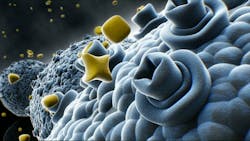'Nano nose' and optoacoustics sniff out prostate cancer
Recognizing that chances of surviving prostate cancer depend strongly on when the disease is diagnosed, scientists have developed a noninvasive method that relies on an electronic "nose" and optoacoustics to improve diagnosis techniques and avoid fatal treatment delays.
An EU research project, called the BOND project, for Bioelectronic Olfactory Neuron Device, could provide early-stage disease detection. Scientists at the University of Barcelona (Barcelona, Spain) have developed the main components of a bio-electronic nose, which is made of electrodes that act as a nerve cord. The artificial olfaction system relies on several hundred nanometric-sized biosensors able to detect the tiniest amount of cancer cells. To accomplish this, the system is dipped into a patient’s urine to relay information concerning the substances contained in the liquid back to the computer.
However, the information collected lacks details about the tumors themselves. So scientists from the Fraunhofer Institute (St. Ingbert, Germany) have begun their own project, Accurate Diagnosis of prostate cancer using Optoacoustic detection of biologically functionalized gold Nanoparticles – a new Integrated biosensor System, or ADONIS, to assess tumor dimension. This project relies on optoacoustics, and involves labeling some of the body's antibodies with gold. The gold-antibody nanoparticles construct is put into solution and injected into patients. Thanks to the ability of antigens to bind to specific receptors on the surface of cancer cells, this device delivers gold nanoparticles into the tumor tissue.
Then, a laser impulse heats the prostate cancer and induces a pressure wave, which can be detected with ultrasound to assess the tumor's shape and size. "The gold particles color the tissue, so this area absorbs more light and sound is produced," explains physicist Robert Lemor of Fraunhofer. The method generates images based on sending a sound wave and recording the reflection signature after it bounces back from our inner cells. When the tumor is marked with the gold nanoparticles, it looks different then the other cells and can be detected. In parallel, the infrared laser beam lights up the tissue and measures its reflection signature. Both together provide scientists with highly sensitive images that can be converted into 3D animations.
The basis of this method has already been tested with animals and first studies with humans are in the planning phase. In the future, scientists want to use a higher laser power as a means to heat the gold particles and subsequently destroy the cancer cells.
